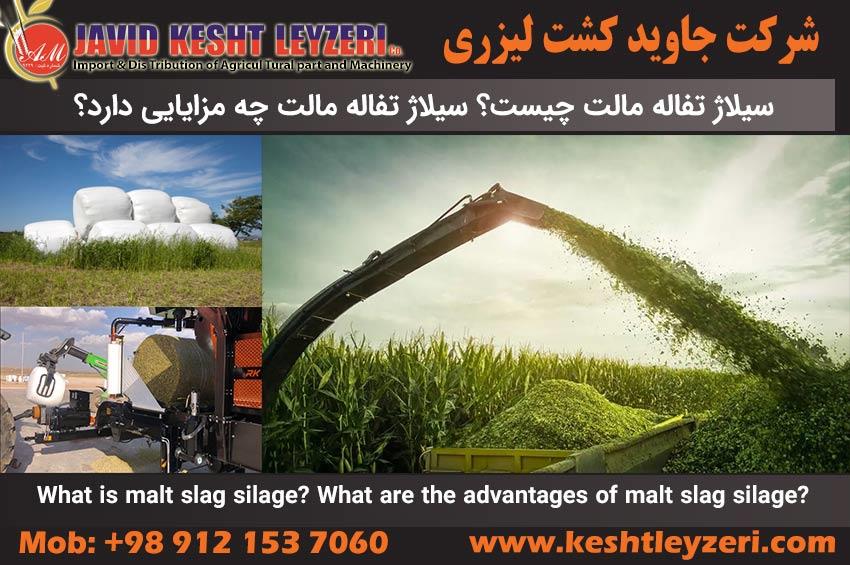
What is malt slag silage? What are the advantages of malt slag silage?
javid keshtleyzeri Co.ltd
Providing animal feed has always been one of the basic and challenging issues in the production of food for humans. Often, due to the lack of natural food for animals, we face many problems in providing animal feed. In recent years, with climate changes and the destruction of many natural pastures, it has become extremely difficult to find natural feed for livestock. For these reasons, in the last few decades, the use of suitable alternatives to natural animal feed, such as malt pomace silage, has received special attention.
In the following, we are going to answer the following questions:
What is malt?
What is the malt production process?
What are the products of malt slag to use as animal feed?
How is malt slag used to provide animal feed?
What is malt slag silage?
What are the advantages of malt slag silage?
What is the effect of using malt sludge or barley sludge in reducing the farmer's cost?
What are the characteristics of packaging malt slag?
What is malt?
When you search for the word "Malt" in Latin in a search engine, you will probably be surprised by the variety and differences between the various findings. In your search, you may come across a tasty drink called "malt". There is also an American dessert with the same name. In addition, "malt" is also used in the production of vinegar. Probably the last thing that will completely confuse you is seeing "malt" as a beverage ingredient. When you search for this word in Farsi, you should also consider the name of a small European country that gained independence only in the last few decades. But what exactly is "malt"? What is the "malt" residue used to produce silage? All of this may seem a bit overwhelming at first with so much disparate data. Simply put, "malt" refers to cereal grains that undergo a special drying process. This drying process gives them special properties that are useful for many applications. These "malt" seeds are used in many aspects of life and bring us pleasure. The number of applications is so large that it is impossible to mention their synchronization.
Malt is obtained from cereal grains, especially barley. In the process of drying the seeds, a sweet taste is also added to them. The reason for this is that before drying, the seeds are placed in water so that they can germinate. Then, using hot air, the germination process is stopped. In this process, a type of sugar called maltodextrin is produced inside the seeds, which makes it sweet. Also, in this process, enzymes are produced that help the fermentation process. For this reason, the use of malt in the beverage industry is very common. In addition, the density of protein and sugar in grains produced from malt is very high, which makes them very suitable for the fermentation process. For this reason, malt is used in many industries and applications. One of its important applications is the use of malt slag in the production of animal feed. By using malt slurry with high percentage of sugar and nutrients, it is possible to produce suitable and economic food for livestock. Also, this food has useful metals such as calcium, which improves it. Globally, rye and barley are the major sources of malt pomace. The quality of malt dregs depends on its production process and in recent years, good quality of malt dregs has been seen all over the world.
What is the malt production process?
- Germination: In this stage, enzymes convert starch into soluble sugars.
- Drying in the oven: the sprouted seeds are dried in the oven and finally turn into malt.
- Washing: Malt is immersed in hot water and then filtered in such a way that the dissolved sugars are separated and a very sweet liquid is produced.
- By-products: In this process, many by-products are produced that can be used as animal feed.
What are the products of malt slag to use as animal feed?
There are many by-products that can be used as animal feed. These products include the following:
- Malt dregs (Malt distillers): Malt dregs or malt extract is the residue obtained after crushing and washing malt. Unlike corn or wheat residues, malt pomace is produced before the distillation process. This slag is sometimes sold directly and sometimes stored for blending with other by-products. However, in recent years, the use and sale of malt slag directly decreased.
- Distillation residual powder (pot ale syrup): This residual powder is the malt distillation process. This powder has high amounts of yeast, soluble proteins and carbohydrates. The color of this powder is dark brown and very sticky. Sometimes it looks like molasses. In the past, this powder was used alone as animal feed, but since the 1960s it is usually mixed with malt pomace and used as animal feed.
- Malt distillers dark grains: This malt is made by combining malt malt and the remaining powder of distillation. After drying, it is shaped into pellets. This product has different protein and carbohydrate compositions, but it has a higher percentage of protein than the malt residue due to the presence of the remaining powder of distillation.
How is malt slag used to provide animal feed?
The use of malt pomace to provide animal feed has been common for a very long time. This use began in Scotland in the late 18th century and continues to be widespread. Malt dregs and malt stills are still used separately. But the combination of the two, i.e. dark grain malt pomace, is used as the main by-product in the sale of malt products. With the increasing cost of the drying process, there is more interest in using the malt residue alone without mixing with the still liquor.
Other sources of malt sludge are from the ethanol fuel production process. Ethanol fuel is used as an additive in gasoline and is mostly produced in Brazil and the United States. Ethanol fuel is often produced from natural biological sources and is also called bioethanol. The use of corn and wheat grains to produce ethanol fuel is common, but the use of barley has been significantly reduced for technical reasons. Barley has a high amount of fiber, which causes problems in the process of making fuel. Also, barley has the lowest amount of starch compared to corn and wheat.
The highest production volume of malt pomace, stillage and dark grain malt pomace using barley occurs in Scotland and Ireland. In other regions of the world, such as the United States, India, and China, the production of malt sludge and ethanol fuel from other grains such as corn and wheat is also common. The use of malt slag as animal feed continues in these areas. Also, in some countries such as Brazil and Argentina, malt sludge is also used as feed for fish farming. In general, the use of malt sludge as a source of feed and fuel in various industries is still thriving and has reduced the wastage of food resources and increased sustainability in agricultural systems.
From the 1990s onwards, the use of barley grain for ethanol production became common. Spain and Finland were known as the most important producers of ethanol from barley grain. However, the use of barley as a feedstock for ethanol fuel production was discontinued after some time. For this reason, the residue from barley ethanol production is very rare and hard to find. Malt dregs are generally stored for use in subsequent processes and have a short shelf life (between 3 and 7 days) in tropical countries. In India, malt slag can only be used under sunlight for about 18 to 24 hours. The remaining liquid after distilling malt (pot ale syrup) has a pH of about 3.5 and is relatively stable. However, if the sterilization process is not performed correctly, there is a risk of microbial degradation and gas production. Therefore, sometimes propanoic acid is used to increase durability and reduce this risk.
What is malt slag silage?
Malt residue silage is one of the best ways to use materials that cannot be used naturally. For example, in many processes, we have to throw away a lot of materials. If there is a way to use these materials as animal feed, it can greatly reduce costs and prevent material from being thrown away.
Malt dregs silage is a type of product obtained from malt dregs. Malt dregs After extracting the sweet part and concentrating a certain part of it as a sweetener, a residue called malt dregs remains. Then this pulp is pressed and dried to become silage.
The use of malt pomace silage in livestock and poultry industries to replace food sources with protein and energy. The protein level in malt pomace silage is very high and contains essential amino acids for animal growth and development. Also, the energy level in silage is relatively high due to the presence of sugars, oils and glucose in it.
Using malt sludge to produce silage is one of the best methods in this field. Using this method, a large amount of suitable and nutritious food is produced for livestock at a low cost. But how is malt dregs actually produced? What are the benefits of silage produced from malt sludge? In this article, you will examine all these points.
What are the advantages of malt slag silage?
The use of malt silage in the livestock feed basket has many advantages, which we will mention a few examples of here:
Helping to grow better and speeding up the breeding process
Can be used for heavy livestock
Increase production of products
Increasing the quality of manufactured products
Improve production efficiency
Economic savings in costs and...
As mentioned earlier, one of the main obstacles in increasing livestock production is the lack of food for them. Malt pomace silage is one of the popular ingredients for animal feed. The reason for this is that malt pomace silage can be used as a side process and therefore can save costs. Also, due to the special malt production process, malt pomace silage contains very high amounts of nutrients for livestock. In the following, we will talk more about the benefits of malt pomace silage... Fresh malt pomace (not mixed with beer), according to the book Vipond et al, which is written about the type of animal feed and its effects on animal growth and nutrition, has Very large amounts of nutrients.
As mentioned earlier, fresh malt pomace can be used directly without mixing with the liquid from distillation and then drying. But in recent years, dark grain malt dregs (that is, malt dregs combined with the remaining liquid of distillation) are mostly used. The reason for this choice is the significant increase in nutrients in malt pomace. These nutrients are able to significantly improve the growth and health of livestock. Below are the main ingredients in dark grain malt pomace... As you can see, the nutrient levels in dark grain malt pomace are much higher than fresh malt pomace. There are about 0.5 carbohydrates in fresh malt pomace, while dark grain malt pomace averages 4.3. Also, it should be noted that this value can reach 11.0 in the right conditions. The level of crude protein in fresh malt pomace is about 20.3, while this value is about 27.8 for dark grain malt pomace. Also, this value can reach 31.1 under suitable conditions. Therefore, it can be assumed that dark grain malt pomace, which is currently used as the main type of malt pomace silage, can be used as animal feed.
The very high amount of brain material in this animal feed can completely solve your concern about proper animal nutrition. The gross energy value of dark grain malt pomace is on average about 21.3 Mj/kg DM, which is very favorable compared to many other animal feeds. Also, under appropriate conditions, this amount may reach 22.5 Mj/kg DM. The amount of calcium in dark grain silage silage is about 1.6 g/kg DM on average, and under the right conditions, we expect it to reach 2.2 g/kg DM. In addition, other food ingredients in this silage also have appropriate amounts, which makes it a suitable feed for livestock. As stated in this article, malt pomace silage is a by-product of the malting process. During the malting process, there are by-products that can be used to provide animal feed. Because the main source of production of this animal feed is a side process, it is relatively profitable from a financial point of view. Sugar and protein levels in malt pomace silage are very high. The reasons for this include the special process of malt production, which has provided these high amounts of carbohydrates. Malt is commonly used to produce beverages and other edible products. There are a wide range of uses for malt, which is why it can be found everywhere.
In past years, direct use of malt pomace as animal feed was common. But now it is generally mixed with the distillation residue and used as animal feed. The reason for this change is that this combination causes a significant increase in the amount of sugar and protein of the malt pomace silage. Therefore, it can be expected that the use of this feed as animal feed has a significant effect on the growth and health of animals. For this reason, in recent years malt pomace silage has become a suitable source of livestock feed. Also, the amount of useful metals such as calcium in malt slag silage is very high. Therefore, by using this feed, animal health can be guaranteed to a great extent.
What is the effect of using malt sludge or barley sludge in reducing the farmer's cost?
Barley bran is one of the products obtained from barley grain. This product is widely used by livestock farmers because of its useful substances and rich salts. In addition to providing animal feed, barley residue also promotes their health and growth. For this purpose, the use of oat pulp increases the appetite and weight of livestock. Some ranchers use this product in its pure form and others mix it with other food ingredients and use it for their livestock feed. Buying oat bran as animal feed is still acceptable. This type of barley slag includes several types and species, all of which are very useful and valuable for raising livestock. Due to its high nutritional value and reasonable price, it is cost-effective to use barley pomace for raising livestock. This product, due to its useful salts and high nutritional value, is suitable for heavy and light livestock feed. Barley pomace has many properties for animal feed. This product is useful and healthy and is known as the best food supplement for livestock. Also, barley bran strengthens the animal's rumen and there are no impurities or additives in it. This product is suitable for sheep and calf feed and it contains about 96% dry matter. Barley pomace has many uses in animal feed and it can be used as one of the most useful food supplements for animals.
The use of malt pomace silage in feeding livestock and poultry as a substitute for food sources with protein and energy is considered for the following reasons:
1. Reducing food wastage: Using malt slag silage as a substitute for food sources with protein and energy helps to reduce food wastage in livestock and poultry industries. By using malt pomace silage, all usable parts of malt pomace are well utilized as a food source for animals.
2. Being economical: compared to other food sources, malt slag silage brings a lower cost for livestock and poultry industries in its first time. Also, the production of malt pomace silage as a substitute for food sources with protein and energy has a lower production cost than other food sources. This issue makes the use of malt slag silage in livestock and poultry industries economical and can reduce production costs.
3. Preservation of the environment: Using malt sludge silage as a substitute for food sources with protein and energy helps to preserve the environment. By using malt sludge as a food source for animals, overuse of natural resources is avoided and as a result, it helps to preserve natural resources and reduce negative effects on the environment.
4. Improvement of efficiency: Silage of malt slag contains protein and high energy that can improve the efficiency of animals. By using malt slag silage in feeding livestock and poultry, the rate of growth and development of animals improves and their performance improves.
5. Reducing dependence on foreign sources: The use of malt slag silage in livestock and poultry industries reduces dependence on foreign food sources. With the production of malt slag silage inside the country, the need to import food resources for the livestock and poultry industry is reduced and it shows the improvement of the country's economy.
Therefore, it is recommended to use malt pomace silage in livestock and poultry industries to replace food sources with protein and energy, considering the reduction of food wastage, being economical, maintaining the environment of livestock and poultry, improving efficiency and reducing dependence on external sources. Using malt sludge silage also helps to preserve the environment and reduces negative effects on the environment.
What are the characteristics of packaged malt slurry (silage)?
High metabolic energy
A suitable substitute for fodder corn in the diet of large and light livestock
Reduction in the price of food rations
Easy to digest due to anaerobic fermentation in the packaging process
Dry matter percentage
Packaged malt pomace is a suitable substitute for fodder corn in the diet of large and light livestock. This slurry has high metabolic characteristics, which means that it participates well in the process of digestion and absorption by livestock.
One of the other features of the packaging malt pulp is the reduction in the price of food ration. By using this waste as a suitable substitute for fodder corn, it is possible to reduce costs in the production of animal feed.
In addition, packaged malt pomace shows simplicity in the digestion process. This is due to fermentation packaged in an airless form, which makes it simple and fast in the process of digestion and absorption by livestock.
Finally, packaged malt pomace has a higher percentage of dry matter than forage corn. This feature makes the bagged malt pomace act as a rich and nutritious feed source for livestock.
According to these characteristics, the use of packaging malt slag in the livestock diet, in addition to being economically lower cost, will also improve the health and growth of livestock.






